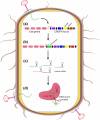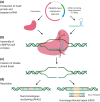CRISPR-based strategies in infectious disease diagnosis and therapy
- PMID: 33393066
- PMCID: PMC7779109
- DOI: 10.1007/s15010-020-01554-w
CRISPR-based strategies in infectious disease diagnosis and therapy
Abstract
Purpose: CRISPR gene-editing technology has the potential to transform the diagnosis and treatment of infectious diseases, but most clinicians are unaware of its broad applicability. Derived from an ancient microbial defence system, these so-called "molecular scissors" enable precise gene editing with a low error rate. However, CRISPR systems can also be targeted against pathogenic DNA or RNA sequences. This potential is being combined with innovative delivery systems to develop new therapeutic approaches to infectious diseases.
Methods: We searched Pubmed and Google Scholar for CRISPR-based strategies in the diagnosis and treatment of infectious diseases. Reference lists were reviewed and synthesized for narrative review.
Results: CRISPR-based strategies represent a novel approach to many challenging infectious diseases. CRISPR technologies can be harnessed to create rapid, low-cost diagnostic systems, as well as to identify drug-resistance genes. Therapeutic strategies, such as CRISPR systems that cleave integrated viral genomes or that target resistant bacteria, are in development. CRISPR-based therapies for emerging viruses, such as SARS-CoV-2, have also been proposed. Finally, CRISPR systems can be used to reprogram human B cells to produce neutralizing antibodies. The risks of CRISPR-based therapies include off-target and on-target modifications. Strategies to control these risks are being developed and a phase 1 clinical trials of CRISPR-based therapies for cancer and monogenic diseases are already underway.
Conclusions: CRISPR systems have broad applicability in the field of infectious diseases and may offer solutions to many of the most challenging human infections.
Keywords: CRISPR gene editing; Infectious diseases; Pandemic viruses; Resistant bacteria; Viral infections.
Conflict of interest statement
Prof. de Mello reports consultant/advisory board for Pfizer, Zodiac, MSD; speaker honoraria from AstraZeneca, Novartis; Educational Grants from Roche, Merck-Group; travel grant from BMS; and expert honoraria from National Science Center, Poland.
Figures


References
Publication types
MeSH terms
Grants and funding
LinkOut - more resources
Full Text Sources
Other Literature Sources
Medical
Miscellaneous

